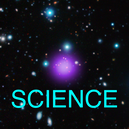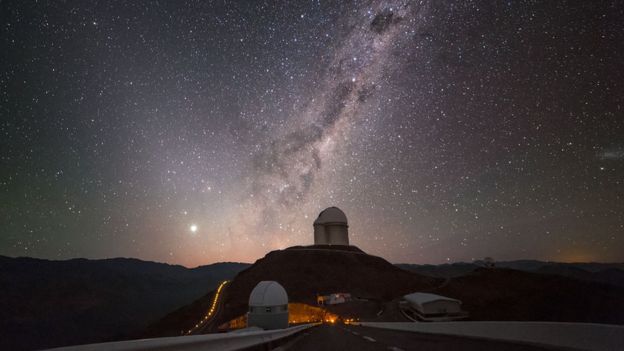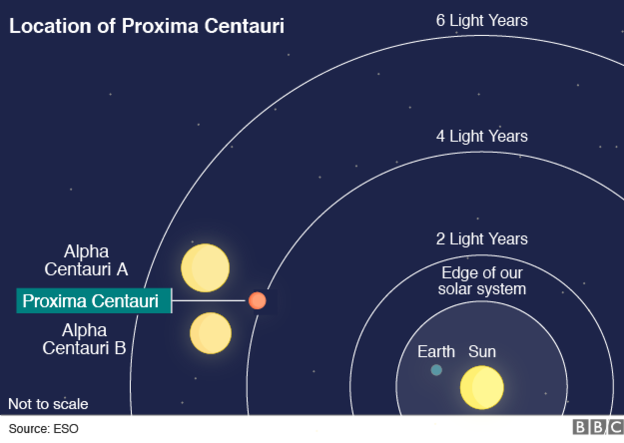|
SCIENCE | วิทยาศาสตร์
กระบวนการค้นหาความจริงด้วยทฤษฎี สมมุติฐาน ค้นหาความจริงของสรรพสิ่งในจักรวาล ด้วยข้อเท็จจริง การศึกษา ค้นคว้า วิจัย ทดสอบ ตรวจสอบ ยืนยันสมมุติฐาน ประกาศยืนยันความจริงจากการค้นพบ และดำเนินกระบวนการทบทวนวิทยาศาสตร์ ซ้ำ ต่อเนื่อง ปฏิเสธความจริงแต่เดิม ประกาศความจริงใหม่บนสมมุติฐานและความจริงที่ค้นพบแต่เริ่มเดิมที มนุษย์แสวงหาความจริงอย่างมิมีที่สิ้นสุด ปราศจากข้อจำกัด ไร้อคติ ด้วยระบบคิดที่ชัดเจนมั่นคง มีทั้งวิทยาศาสตร์บริสุทธิ์ วิทยาศาสตร์ประยุกต์ วิทยาศาสตร์ปรัชญา วิทยศาสตร์แห่งมนุษย์ สิ่งแวดล้อม การเมือง เศรษฐกิจ ส้งคม สิ่งแวดล้อม ฯลฯ |
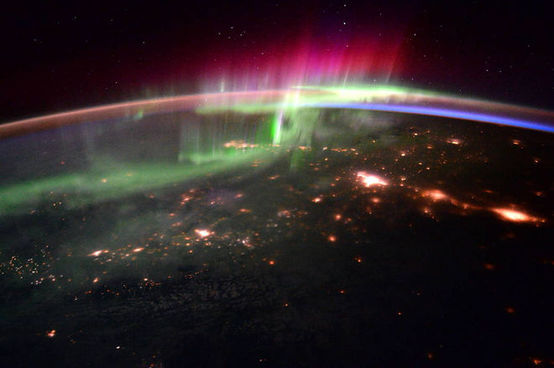
Aurora View from Space Credit: ESA/NASA Monday, September 12, 2016 This is a view of a beautiful aurora as seen from the International Space Station. The bright pink, green and blue lights of the aurora dance over the Pacific Northwest, creating not only a spectacular light show for those on Earth, but for those on the space station, too. NASA astronaut Scott Kelly and ESA astronaut Tim Peake shared a series of aurora photographs on Twitter on Jan. 20 that were taken during their stay on the orbiting lab. Among them was this photo. — Samantha Mathewson www.space.com/34-image-day.html?utm_source=facebook&utm_medium=facebook&utm_campaign=socialfbspc&cmpid=social_spc_514630 |
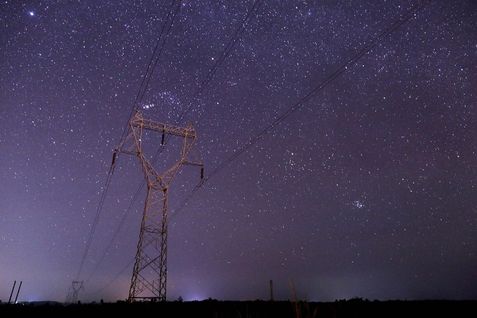
'Strong signal' stirs interest in hunt for alien life AFP August 30, 2016 Washington (AFP) - A "strong signal" detected by a radio telescope in Russia that is scanning the heavens for signs of extraterrestrial life has stirred interest among the scientific community. "No one is claiming that this is the work of an extraterrestrial civilization, but it is certainly worth further study," said Paul Gilster, author of the Centauri Dreams website which covers peer-reviewed research on deep space exploration. The signal is from the direction of a HD164595, a star about 95 light-years from Earth. The star is known to have at least one planet, and may have more. The observation is being made public now, but was actually detected last year by the RATAN-600 radio telescope in Zelenchukskaya, Russia, he said. Experts say it is far too early to know what the signal means or where, precisely,it came from. "But the signal is provocative enough that the RATAN-600 researchers are calling for permanent monitoring of this target," wrote Gilster. The discovery is expected to feature in discussions at the 67th International Astronautical Congress in Guadalajara, Mexico, on September 27. "Working out the strength of the signal, the researchers say that if it came from an isotropic beacon, it would be of a power possible only for a Kardashev Type II civilization," Gilster wrote, referring to a scale-system that indicates a civilization far more advanced than our own. "If it were a narrow beam signal focused on our Solar System, it would be of a power available to a Kardashev Type I civilization," indicating one closer to Earth's capabilities. Gilster, who broke the story on August 27, said he had seen a presentation on the matter from Italian astronomer Claudio Maccone. "Permanent monitoring of this target is needed," said the presentation. Nick Suntzeff, a Texas A&M University astronomer told the online magazine Ars Technica that the 11 gigahertz signal was observed in part of the radio spectrum used by the military. "If this were a real astronomical source, it would be rather strange," Suntzeff was quoted as saying. "God knows who or what broadcasts at 11Ghz, and it would not be out of the question that some sort of bursting communication is done between ground stations and satellites," Suntzeff said. "I would follow it if I were the astronomers, but I would also not hype the fact that it may be at SETI signal given the significant chance it could be something military.” Photo credit: A "strong signal" detected by a radio telescope in Russia that is scanning the heavens for signs of extraterrestrial life has stirred interest among the scientific community (AFP Photo/Ye Aung Thu) https://www.yahoo.com/news/strong-signal-stirs-interest-hunt-alien-life-171536443.html |
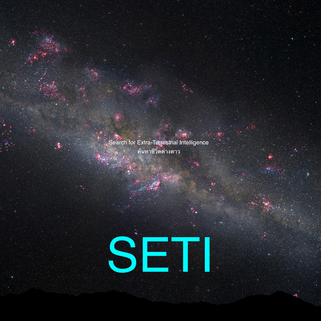
SEARCH FOR EXTRA-TERRESTRIAL INTELLIGENCE
การค้นหาชีวิตอุดมปัญญานอกโลก 'สัญญาณกำลังแรง’ สร้างความสนใจในการค้นหามนุษย์ต่างดาว 'STRONG SIGNAL' STIRS INTEREST IN HUNT FOR ALIEN LIFE AFP AUGUST 30, 2016 WASHINGTON (AFP) - ที่รัสเซีย มีการตรวจพบสัญญาณกำลังแรงจากกล้องดูดาวด้วยคลื่นวิทยุ ที่ทำหน้าที่กวาดท้องฟ้าหาสัญญาณของสิ่งมีชีวิตต่างดาว หลังจากได้เปิดเผยข่าวนี้แล้วเมื่อวันที่ 27 สิงหาคม นี้ ก็สร้างความตื่นเต้นฮือฮาให้กับวงการวิทยาศาสตร์ทั่วโลกเป็นอย่างมาก “ไม่ได้มีใครคิดว่าสัญญาณที่ได้รับจะมาจากอารยธรรมมนุษย์ต่างดาวที่ไหนแต่อย่างใด แต่เรื่องนี้ก็น่าสนใจ สมควรจะได้ศึกษาค้นคว้าต่อไป”, PAUL GLISTER กล่าวใน CENTAURI DREAM WEBSITE ของเขา ซึ่งเป็น WEBSITE ทบทวนตรวจวิพากษ์งานวิจัยต่างๆจากเพื่อนนักวิทยาศาสตร์ด้วยกันเอง เฉพาะเรื่องการสำรวจห้วงลึกแห่งอวกาศ สัญญาณกำลังแรงที่ว่าได้ตรวจพบนั้นพุ่งมาจากดวงดาวชื่อ HD164595 ซึ่งอยู่ห่างจากโลก 95 ปีแสง ดาวดวงนี้ (หรืออาจจะเรียกว่าดวงอาทิตย์ก็ได้) มีข้อมูลอยู่แล้วว่ามีดาวเคราะห์โคจรรอบอยู่ดวงหนึ่ง หรืออาจจะมากกว่าหนึ่งดวงก็ได้ การประกาศว่าได้พบสัญญาณกำลังแรงนี้แม้จะเพิ่งประกาศ แต่ที่จริงเรื่องการตรวจพบสัญญาณนี้เกิดตั้งแต่ปีที่แล้ว เพียงแต่เก็บไว้เป็นความลับก่อนเท่านั้นเอง รัสเซียแถลงว่ากล้องที่ใช้ส่องสำรวจดวงดาว เป็นกล้อง RATAN-600 RADIO TELESCOPE ตั้งอยู่ที่หอดูดาวเมือง ZELENCHUKSKAVA นักวิทยาศาสตร์ผู้เชี่ยวชาญกล่าวว่ายังเร็วเกินไปที่จะบอกว่าสัญญาณที่ว่านั้นมีความหมายว่าอย่างไร หรือมาจากไหนกันแน่ชัด แต่ PAUL GLISTER ก็บอกว่า “สัญญาณนั้นก็ท้าทายมากพอที่จะทำให้นักวิทยาศาสตร์ติดตามศึกษาเป็นการถาวรที่หอดูดาว ZELENCHUKSKAYA ต่อไป การค้นพบครั้งนี้จะเป็นประเด็นสัมมนาในที่ประชุมครั้งที่ 67TH ของ INTERNATIONAL ASTRONAUTICAL CONGRESS ที่เมือง GUADALAJARA, MEXICO ในวันที่ 27 กันยายน 2016 นี้ “การวิเคราะห์กำลังส่งของสัญญาณจากแนวคลื่น ISOTROPIC BEACON ที่แรงขนาดนี้ทำให้เชื่อว่าต้องเป็นลักษณะสัญญาณจากอารยธรรมแบบ KARDASHEV TYP II เท่านั้น”, GLISTER อธิบาย โดยอ้างถึงระบบมาตรวัดสัญญาณจากอวกาศที่จัดแบ่งตามความเจริญของอารยธรรมของที่มาของสัญญาณที่มีความเจริญมากกว่าโลกมนุษย์ของเราเอง “ถ้าหากว่าเป็นสัญญาณที่พุ่งมาเป็นทางแคบ ส่งตรงมายังระบบสุริยะของเราโดยเฉพาะเท่านั้น ก็จะจัดให้เป็นสัญญาณอารยธรรมแบบที่ I หรือ KARDASHEV TYPE I CIVILIZATION”, ซึ่งมีความหมายว่าสัญญาณมาจากระยะใกล้โลกมากกว่า แบบที่ II (TYPE II) GLISTER ผู้เปิดเผยข่าวนี้เมื่อวันที่ 27 สิงหาคม 2016 บอกว่า เขาได้เห็นรายงานเรื่องนี้จากนักดาราศาสตร์ชาวอิตาเลียน ชื่อ CLAUDIO MACCONE ผู้ซึ่งย้ำว่าจะต้องมีการติดตามเฝ้าดูสัญญาณนี้อย่างถาวรต่อเนื่อง NICK SUNTZEFF นักดาราศาสตร์จาก TEXAS A&M UNIVERSITY ให้สัมภาษณ์ ARS TECHNICA ONLINE ว่า สัญญาณที่ได้เป็นสัญญาณ 11 GIGAHERTZ เหมือนที่ใช้ในวงการทหาร เขาบอกว่า “ถ้าเป็นสัญญาณจากนอกโลกก็จะต้องนับว่าเป็นเรื่องแปลกมาก...ใครจะไปรู้ได้ มันอาจจะมาจากการสื่อสารของพวกทหารจากภาคพื้นดิน ไปยังดาวเทียมแล้วสัญญาณกระจายออกมาก็ได้ เพราะเป็นสัญญาณ 11 GHZ. แบบเดียวกันกับที่ทหารใช้ ... ถ้าเป็นผม ผมก็จะติดตามเฝ้าดูต่อไป แต่ไม่ควรไปสร้างข่าวให้ฮือฮาว่าเป็นสัญญาณจากอารยธรรมต่างดาว ดีไม่ดีมันอาจเป็นสัญญาณจากพวกทหาร(รัสเซีย)ก็ได้” ข่าวเพิ่มเติมก่อนหน้านี้ : เมื่อวันที่ 24 สิงหาคม 2016 ที่ผ่านมา ก็มีการประกาศการค้นพบดาวเคราะห์ขนาดและสภาวะคล้ายโลกมนุษย์ของเรา โคจรรอบดวงดาวชื่อ PROXIMA CENTAURI ซึ่งเป็นดาวฤกษ์ หรือดวงอาทิตย์ที่ใกล้ระบบสุริยะของเรามากที่สุด อยู่ในแกแล็กซี่ทางช้างเผือกของเราด้วยกันเอง ตั้งชื่อดาวเคราะห์ดวงนี้ว่า PROXIMA B ห่างจากโลกมนุษย์เพียง 4.22 ปีแสงเท่านั้น (40 TRILLION กิโลเมตร) - มนุษย์จะต้องใช้เวลาเดินทางหลายพันปี กว่าจะไปถึง - ด้วยเทคโนโลยีปัจจุบันก็คงยังไปไม่ถึง แต่ข่าวเรื่องดาวเคราะห์นอกระบบสุริยะทำนองนี้ทำให้ความคิดที่ว่ามีสิ่งมีชีวิตเกิดขึ้นได้บนโลกอื่น นอกจากโลกมนุษย์ เป็นเรื่องที่เป็นไปได้ เพียงแต่ต้องรอกาลเวลาและการศึกษาต่อไปเรื่อยๆ PROXIMA B นี้ โคจรอยู่ในวงโคจรที่มีภสาพแลดล้อมเหมาะสมที่จะให้กำเนิดน้ำและชีวิตได้ ที่ว่าเราไม่ได้อยู่คนเดียวโลกเดียวในเอกภพนั้น ท่าจะแน่นอน! 30 สิงหาคม 2559 HTTP://WWW.SPACE.COM/33838-PLANET-PROXIMA-B-FULL-COVERAGE.HTML HTTP://WWW.BBC.COM/NEWS/SCIENCE-ENVIRONMENT-37167390 HTTP://WWW.BBC.COM/NEWS/SCIENCE-ENVIRONMENT-37180499 |
Neighbouring star Proxima Centauri has Earth-sized planet
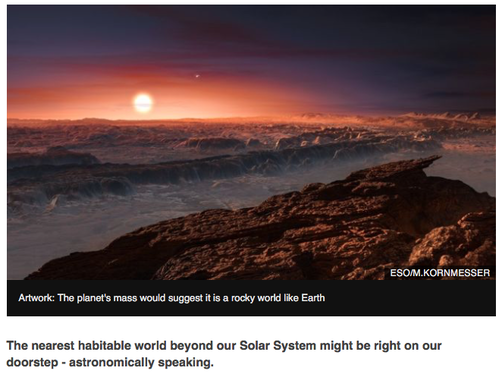
Science & Environment
Neighbouring star Proxima Centauri has Earth-sized planet By Jonathan AmosBBC Science Correspondent24 August 2016 The nearest habitable world beyond our Solar System might be right on our doorstep - astronomically speaking. Scientists say their investigations of the closest star, Proxima Centauri, show it to have an Earth-sized planet orbiting about it. What is more, this rocky globe is moving in a zone that would make liquid water on its surface a possibility. Proxima is 40 trillion km away and would take a spacecraft using current technology thousands of years to reach. Nonetheless, the discovery of a planet potentially favourable to life in our cosmic neighbourhood is likely to fire the imagination. "For sure, to go there right now is science fiction, but people are thinking about it and it's no longer just an academic exercise to imagine we could send a probe there one day," said Guillem Anglada-Escudé whose "Pale Red Dot" team reports the existence of the new world in the journal Nature. Earlier this year, the billionaire venture capitalist Yuri Milner said he was investing $100m in studies to develop tiny spacecraft that could be propelled across the galaxy by lasers. These would travel at perhaps 20% of the speed of light, shortening the journey to a star like Proxima Centauri to mere decades. Just how "habitable" this particular planet really is, one has to say is pure speculation for the time being. The Queen Mary University of London researcher and his group concede they still have much work to do to extend their observations. Simply identifying the world, catalogued as "Proxima b", was a considerable challenge. It was made possible through the use of an ultra-precise instrument called HARPS. This spectrograph, attached to a 3.6m telescope in Chile, detects the very slight wobble induced in a star when circled by a gravitationally bound planet. Its data suggests Proxima b has a minimum mass 1.3 times that of Earth and orbits at a distance of about 7.5 million km from the star, taking 11.2 days to complete one revolution. The distance between the star and its planet is considerably smaller than Earth's separation from the Sun (149 million km). But Proxima Centauri is what is termed a red dwarf star. It is much reduced in size and dimmer compared with our Sun, and so a planet can be nearer and still enjoy conditions that are potentially as benign as those on Earth. "This planet is at 5% of the Earth's distance from the Sun. However, Proxima is 1,000 times fainter than the Sun. So the flux - the energy - reaching Proxima b is about 70% of what the Earth receives. It's like taking Earth a bit further away, but it's comparable," explained Dr Anglada-Escudé. Whether the temperatures on Proxima b are favourable for life to exist is going to depend on the presence of an atmosphere. An envelope of greenhouse gases would warm surface conditions and provide sufficient pressure to keep water - essential for biology - in a liquid state. But even with the limited information we currently have, scientists are excited by the news. ⤴️ |
"I think it's the most important exoplanet discovery there will ever be - how can you ever trump something that could be habitable orbiting around the very closest star to the Sun?" commented Dr Carole Haswell from the Open University.
"When I was a kid, it wasn't clear there were any other planets that we could walk around on and find liquid water on - so I think it's absolutely thrilling," she told BBC News. Analysis - David Shukman, BBC Science Editor This is a huge moment in the search for alien worlds. Until 1992, the only planets anyone knew about were the ones in our own solar system. But since then thousands more have been found orbiting distant stars and the belief is that the galaxies may be teeming with them. Most would be extremely inhospitable to life: too big or too hot or too cold. The newly found Proxima b does not sound like much of a paradise either. It is roughly Earth-sized and should be the right temperature for liquid water but it is bathed in sepia light and vulnerable to violent flares so it is definitely not Earth-like. However the fact that it is so close to us - in the relative terms of deep space - suddenly improves the chances of investigating if an exoplanet can be genuinely habitable. So expect this announcement to trigger a mass swivelling of telescopes towards a very particular point in space. In just two decades, astronomers have moved from amazement at finding any new worlds at all to discovering the most tantalising of them all right on their doorstep.
Researchers are presently looking to see if the planet crosses the face of Proxima Centauri as viewed from Earth - an event referred to as a "transit". This kind of backlit observation could confirm not just the existence of an atmosphere but reveal perhaps something of its chemical properties. Indeed, researchers have long talked about using transits to try to detect the signatures of life on planets that are too far away to be visited by spacecraft. If there are lifeforms on Proxima b - even simple microbes - they may find the going rather tough, however. Red dwarfs are very active. They tend to throw out big flares that would bombard a nearby planet with energetic particles. The X-ray emission is much more intense as well. Even so, these kinds of stars are now the subject of great interest in the search for Earth-like planets simply because they are so abundant in the galaxy. One priority for the future will be to get a direct image of the planet. This should be possible with the European Extremely Large Telescope now under construction in Chile. It is being given a 39m-wide primary mirror and state-of-the-art instrumentation precisely to do this kind of observation. "A planet around even a wimpy star like Proxima Centauri is going to be more than a billion times fainter than the star itself. So, what you do is block out the light from the star using a special device and that allows you then to go deeper into the star's surroundings," explained Cambridge University's Prof Gerry Gilmore. "This is one of the E-ELT's design goals. There's also a Nasa mission under development called W-First. It will have a high-resolution coronagraphic mode which again is designed for the same purpose."
[email protected] and follow me on Twitter: @BBCAmos BBC original report with ©pictures http://www.bbc.com/news/science-environment-37167390 |

